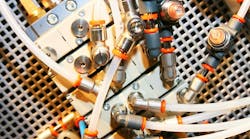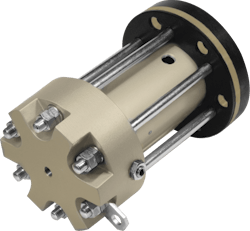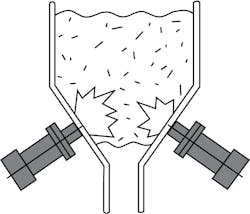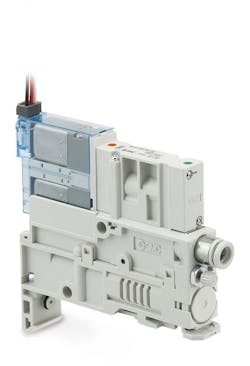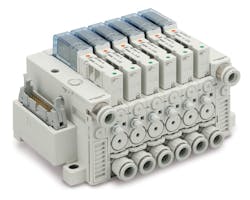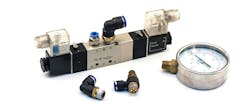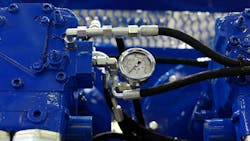Improve Pneumatic System Efficiency: Key Steps to Follow
The creation of efficient pneumatic systems can bring a range of benefits and is becoming increasingly important for industries looking to reduce energy and operating costs as well as their carbon footprint.
To do so, a system-wide approach must be taken said Jon Jensen, CFPPS, CFPECS & CFPAI, Industry Projects Manager – Energy, SMC Corporation of America (no relation to author), during a webinar with Power & Motion. “Most of us agree that we should focus on the demand side first,” he said. “If we can reduce the demand for compressed air, all of the efficiencies will fall into place.”
He noted it is also necessary to check how air is supplied in the compressor room to ensure optimal energy savings. “In the best scenario, the system is flexible enough to capitalize on those savings on its own. If not, there may need to be some work done on the supply side to make sure that adjustments are made to capture the savings that we get from reducing demand in our pneumatic systems.”
Addressing Inefficient Air Delivery Mechanisms Offers High Energy Savings
Jensen said inefficient air delivery mechanisms are typically related to air being blown onto something for a purpose that does not involve an actuator. In this case the air may be used to move, cool, or guide a product or it could be used to cool electrical cabinets, mix liquids, or reject a defective product.
“A lot of these applications are usually not well engineered,” he said. “They're typically added after the fact or during a machine's installation, and not necessarily connected to the machine’s controls.”
Because of this, there are often open tubing or pipes, unregulated pressure and the delivery mechanism for the air may be located too far away. It may also be misdirected and not automated and might not turn off when the machine turns off. These and several other issues are possible, all of which can negatively impact the efficiency of a pneumatic system.
“These use a lot of energy and are relatively easy to improve if you put a little thought into it,” said Jensen.
The first step is to measure the consumption to determine what is happening. This also allows better calculation of the cost associated with a particular application and how much to possibly spend on improving it while still getting a return on your investment.
Using high-efficiency air nozzles is one of the solutions to consider employing. For applications requiring more volume, Jensen said an air amplifier might be the right option to minimize inefficiencies.
He said the shut off for a system should always be automated to ensure air is blowing only when necessary and is always operating at the lowest effective pressure.
Another potential solution is pulsing the air for a pneumatic system instead of having a continuous blow. In addition to the energy savings possible, typically about 50%, there is also the benefit of peak pressure. “Every time the air comes on, the pressure delivered – where the air is blowing – is slightly higher than a continuous pressure. That gives you a little more effective operation especially if you're using the air to clean or move debris or remove particles from a work area,” explained Jensen.
He said looking at inefficient air delivery mechanisms and addressing them is an easy way to achieve energy savings with minimal investment.
READ MORE: Preventing Common Mistakes in Selecting Valves
Evaluate Alternatives for Energy Intensive Pneumatics Applications
When it comes to addressing energy intensive applications, Jensen said it is beneficial to look at the pneumatic components commonly used in them. Although they may help get the work done, these components can use a lot of energy and alternative options may be a better fit.
One such example is pneumatic vibrators which are often used on hoppers or bins of material to keep the material from sticking inside the hopper. However, these devices are energy intensive. An alternative option would be to use an impact cylinder instead which delivers a momentary shock to the bin to move the material.
Air vortex tubes are another energy-intensive device. Effective for electrical cabinet cooling, they are also a high-energy user of compressed air said Jensen. “If you're using a device like this to cool a cabinet, it's always good practice to equip the circuit with a thermostat and a shutoff valve so that the air is only on when the cabinet requires cooling and doesn't get left on the entire time,” he said.
For product reject applications, he said a potential option is to use a high-speed valve. Instead of blowing air continuously this type of valve provides a high-speed burst of air to remove a product. The air is provided over a short duration and is effective at removing products a manufacturer may want to reject from its line, such as a partially empty package.
Jensen said vacuum venturis can be an energy-efficient component option to consider for some applications as well. These devices use compressed air to generate a vacuum. “The traditional method is to supply air continuously while you are requiring the vacuum to be generated to pick up a workpiece, for example,” he said.
He noted newer technologies use multi-stage venturis which are more efficient than the legacy single-stage types. They are also equipped with automatic shutoff, enabling the compressed air supply to be turned off when the level of vacuum is sufficient to hold a part in place or lift a workpiece. “It applies vacuum only when required and gives you considerable savings.”
READ MORE: Understanding the Fundamentals of Vacuum Technology
Prevent Over-Pressurized Pneumatic Systems
Maintaining proper pressure is important to the performance of pneumatic systems. “We always want the correct pressure in the correct place,” said Jensen.
Pressure can also influence the efficiency of a system. “We always want to take a look at pressure because the higher pressure you need, the more molecules of air that have to be squeezed into the application and that requires energy,” he explained. “So higher pressure always requires more energy when you’re producing air.”
Jensen said there are clues which indicate if too much pressure is being used in an application. These include applications not fitted with a pressure regulator or in which the pressure regulator is set to line pressure – most machines should operate below the pressure being delivered from the compressor room.
If identical machines are operating at different pressures, it can be another indicator of an over-pressurized application. Machines operating at much higher pressures than others should be examined to determine the root cause of the difference in pressure levels so corrective actions can be taken.
It is also important to verify a machine’s pressure requirement; OEMs will often include a placard on their machine stating its working pressure. Often, the pressure gauge next to the placard is set at a higher pressure than what is stated. Verifying what pressure is actually required and setting the system to it can be an important step in achieving energy efficiency.
“Many machines operate at or below 75 psi,” said Jensen. “There's actually a trend in our industry to start to consider operating at 60 psi. Several of the larger customers in the world are starting to consider this idea where lower pressure is the requirement for new machines and potentially, to set existing machines at the lowest possible pressure.”
For every 2 psi you lower the pressure, it is possible to get about 1% energy savings he said.
Consider Different Design Options
Designing for minimum flow and pressure is another method which can be used to prevent a pneumatic system from being over pressurized. “One of the strategies is to use variable pressure,” he said. “You may use an electropneumatic regulator so that the machine’s control system adjusts the pressure to the right level for different product or even for different parts or times in the machine’s operational cycle.”
Another strategy which can be employed is using minimum pressure for the application. If the whole machine does not require the same pressure, Jensen said you can divide the machine into sections which use different pressures where appropriate. “That could go all the way down to even reducing the pressure on the actuator’s non-working stroke.”
He offered the example of a speed controller with built-in pressure reduction function – a cylinder does its work in the extend direction but when it retracts, it is not moving the load so it can retract at a much lower pressure.
“There are any number of choices of devices like this where it's very simple to get a pressure reduction function without making any revisions to the circuit other than changing the component from a standard speed control type to one that includes pressure reduction,” he said.
This concept could be taken a step further with the addition of an exhaust return circuit which would enable air from the working stroke to be reused for the retract function to use less compressed air. “This is a little more complicated and requires some creative plumbing, but it's also very effective, especially in larger size actuators,” said Jensen.
In applications where one aspect, such as an actuator, needs a different pressure than the rest of the machine, use of a pneumatic booster can be beneficial. The supply or ideally the compressor is set at a lower pressure he said, or a compressor designed for a lower pressure is utilized, and a pneumatic booster raises the pressure up for the higher force application. “This can be a very strategic way to get the correct pressure in the correct place which again reduces the airflow.”
How to Save Energy During Idle Modes
According to Jensen, idle mode is defined as having the machine pressure supply on but the machine not in production. He said older machines were typically designed to pause operations without changing the pressure.
Improvements in this design have occurred over the years, but it is still common for machines to continue using the same amount of pressure even if they stop for some reason such as an error or a jam.
“When the machine stops and the pressure is on at a high level, any flow through that machine can indicate air leaks, which should be fixed, or it can be other demands for air like the vacuum venturi or air blow,” said Jensen. “This is all what we lump into the title of artificial demand.”
In these instances, it can be beneficial to check whether it is possible to remove or reduce the pressure when the machine is idle. Verifying if there is a shut off valve can help overcome artificial demand as well. He said many machines have one, but it may not be programmed to operate as desired and so could be adjusted.
“If the pressure is on during idle mode, let's measure that flow and we can estimate those potential savings,” which could be achieved by adjusting it he added.
READ MORE: Compressed air may be more efficient than you think
Better Pneumatic System Monitoring Can Sustain Efficiency Efforts
To help keep pneumatic systems operating efficiently, Jensen believes it is necessary to make the production machines on which they are used “at least as smart as your average automobile.”
Cars today have monitors and sensors all over them gathering a wide range of data while they operate and provide a warning if an issue is detected. “We'd like to make the machines that we see in our factories at least that smart,” he said. “And the way we do that is by monitoring.”
He noted this can be done in several ways such as general monitoring and visual indication or a flow meter could be used which is programmed to change color when the flow rate is out of a desired range or higher than it is expected to be.
If building a machine from scratch, it is possible to design in a self-check, diagnostic or leak detection subroutine so the machine would provide an indication when it is using more air than needed and what is causing that to occur.
As a further step, strategic monitoring using the Industrial Internet of Things (IIoT) and data analytics could be used. This can provide even more data when a problem happens and what the cause might be.
New and existing machines can benefit from the collection of pressure and flow data. Doing so can make it easier to automate air flow as needed, such as reducing it during idle times to save on energy use. The data can also help with detection of changes in pressure or flow which are out of line with baseline operating conditions.
With data collection it is possible to do predictive maintenance as well. Jensen said that in general, the failure of a pneumatic component is predicted by a leak – not always, but in many cases. “If we start to see flow rates going up for no particular reason, we typically know that there's a problem in that part of the circuit and we can schedule maintenance before it actually fails,” he said. “And that can be done using data analytics and creating a dashboard that would flag those anomalies and alert the operational team if something needs to be done.”
READ MORE: Predictive Maintenance Systems Enable Better Machine Monitoring
Data collection can aid with the transition to digitalization as well, allowing not only the collection of system performance data but also enabling comparisons and benchmarking of similar machines and remote monitoring and control. Jensen said the information can also be integrated with other non-pneumatic sensor data, such as vibration or amperage, to assess the energy consumption of an operation.
“The basic things to take away are we want to implement energy saving measures – take a look around and see what's possible, apply the correct solutions to those energy saving measures, start to design for lowest total cost of ownership, and of course, improve existing equipment for lowest total cost of ownership, and then monitor to sustain all that hard work that we've done,” he concluded.
